June, 1938
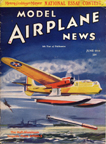
Hall Aluminum Aircraft Co.XPTBH-2
Model Airplane News Cover Art for June, 1938
by Jo Kotula
Click to Enlarge
The Hall Aluminum Aircraft Company's XPTBH-2 was a twin-engined seaplane submitted to the U.S. Navy in a 1937 competition for bomber aircraft. This competition led to the TBD Devastator and SB2U Vindicator among others, however the XPTBH-2 was not ordered for production, and the company soon went bankrupt.
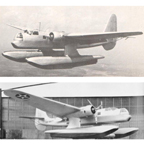


Photos of the Hall Aluminum Aircraft Co.XPTBH-2
Aluminum Construction Patent No. 1,847,559
Click to Enlarge
The XPTBH-2 was the only prewar Navy plane designed for three missions: Patrol, Torpedo, and Bombing. Thge navy had specified hat the plane had to be capable of dropping the standard destroyer-type torpedo which was almost twice the size of aerial torpedoes then in use. The twin-float seaplane (with torpedo carried between the floats) was thought to be the best solution to this problem. A monoplane design was needed to attain the speed necessary for the bombing role; in order to achieve an aerodynamically clean aircraft, the wing wast to be cantilevered -- supported internally without external wires or braces. In order to thisfor an 80 foot wingspan required a 36 inch diameter aluminum tube as the main spar; it was paced at the center of pressure and carried both the flight and water loads. An ingenious truss system eliminated the need for cross-bracing the floats, so that the torpedo could be carried between them. The wing had an aluminum leading edge, but the rest was fabric covered.
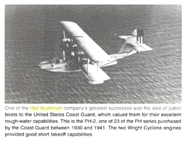
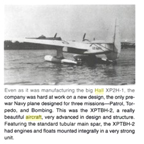
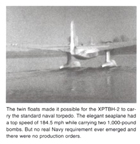
Hall Aluminum Aircraft Co. XPH-2 and XPTBH-2
Click to Enlarge
The fuselage was of semimonocoque construction (see Patent Diagram No. 1,847,559 above). The nose held a revolving turret with a single 30 caliber machine gun.
The copilot served as navigator, bombardier and torpedoman. The flight mechanic and radio operator doubled as gunners. Rear defense was provided by two machine guns, one mounted in a dorsal opening and another in a ventral position.
The only modification needed after the test flight was an "under-fin" to provide additional vertical surface to offset aair flow effects from the floats. This is seen quite clearly in the M.A.N cover isslustration reinforcing the notion that these illustrations were technically accurate as well as aesthetically pleasing.
All-in-all the XTPBH-2 was a success, meeting performance requirements on all three of its intended missions. It had a top speed of 180 mph. Unfortunately, the Navy had no interest in the project and the sole example of the XPTBH-2 was destroyed while moored at the Naval Torpedo Station, Newport, Rhode Island.
during the hurricane of 1938.The Hall company faced serious financial challenges and was eventually taken over by Consolidated Aircraft.
Click here for more information about the Hall Aluminum Aircraft Company and the XPTBH.

Click to go back and select another cover.
Counter for the Entire Site (not just this page..)
Home | About Lindy | Last Week's Reviews | Upcoming Events | 1940s Collecibles
The Guide - Establishments - Travel - Accessories
Music | Links | Photo Gallery | Extras | Contact